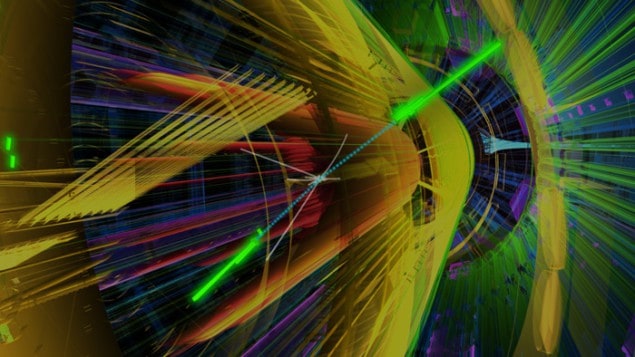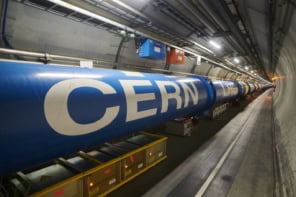
Last year, the LHC’s ATLAS and CMS experiments both reported a small “bump” in their data that denoted an excess of photon pairs with a combined mass of around 750 GeV. As this unexpected bump could be the first hint of a new massive particle that is not predicted by the Standard Model of particle physics, the data generated hundreds of theory papers that attempt to explain the signal. Of these, four different theoretical explanations – a particle predicted by a lesser-known version of supersymmetry; a particle linked to a new kind of strong nuclear force; a Higgs-like boson; and a decay product from other very heavy particles – have been selected for publication in this week’s issue of Physical Review Letters.
Statistical confidence?
The 750 GeV “diphoton” excess was announced by ATLAS and CMS in December last year and then confirmed, with slightly more confidence overall, by both collaborations at a meeting in La Thuile in northern Italy last month. Taking into account what is known as the “look-elsewhere effect” (the fact that across a range of energies some bumps are bound to appear by chance), CMS says it has seen an excess with a statistical significance of 1.6σ, while ATLAS reports a significance of about 2σ – corresponding, respectively, to a roughly 1 in 10 and 1 in 20 chance that the result is a fluke.
While these levels are far below the 5σ “gold standard” that must be met to claim a discovery, the fact that both collaborations saw a bump at the same energy has excited theoretical physicists. Indeed, since December, theorists have uploaded more than 250 papers on the subject to the arXiv preprint server.
In an editorial note, PRL editor Robert Garisto says that he and his colleagues “found it appropriate to publish a small sample” of those papers submitted to the journal, and that they then sought informal advice about which papers to choose. The resulting four, he explains, give readers “a sense of the kind of new physics that would be required to explain the data, if confirmed”.
Another boson
The authors of three of the four papers show how the bump could be caused by a boson with a mass of 750 GeV (the integer spin of a boson being needed to generate two (spin 1) photons). Gang Li and colleagues from Peking University in China propose a particle similar to the Higgs boson, which was itself discovered via a (125 GeV) peak in the energy spectrum of photon pairs at the LHC. The researchers say that the new particle would be produced by fusing gluons, positing that both that transformation and the boson’s conversion into photons would be mediated by other particles from beyond the Standard Model. Such mediation, they explain, would effectively prevent decay into particles other than photons, such as W or Z bosons, which are observed in the case of the Higgs but not at the higher energies considered here.
Another of these papers – by Yuichiro Nakai of Harvard University in the US, together with colleagues in Israel and Japan – suggests that the bump seen by the CERN experiments is down to a pion-like boson that is part of a new theory similar to quantum chromodynamics, which describes the strong force.
Supersymmetric gold?
Alternatively, according to Christoffer Petersson of Chalmers University of Technology in Sweden and Riccardo Torre of the EPFL in Switzerland, the data point to a particle known as a “sgoldstino” – this would be the bosonic partner of a fermion known as the goldstino, which is associated with the breaking of perfect supersymmetry. (According to supersymmetry, each boson has a fermion superpartner and vice versa; perfect symmetry would mean the two particles in each pair have the same mass, which is not observed.)
Petersson notes that the supersymmetry in question is not the “minimal” model most commonly studied by physicists, which predicts symmetry breaking at very high energies. The alternative put forward here instead involves symmetry breaking at low energies. “The minimal model can’t account for the observed excess [at 750 GeV],” he says. “So if this excess is true, we need to go beyond that model.”
More particles?
Finally, Won Sang Cho of the Institute for Basic Science in South Korea and colleagues argue that the particle or particles responsible for the excess do not necessarily have a mass of 750 GeV. Instead, they say, it is possible that the bump is caused by much heavier particles decaying into the two photons, as well as one or more additional particles.
As to whether the bump is a real particle as opposed to a statistical effect, physicists should not have to wait too much longer to find out. CMS spokesperson Tiziano Camporesi told physicsworld.com that his experiment should have collected enough data to provide a “hint” about this by about mid-June. He adds that the team is aiming to update its result in August – by which time both CMS and ATLAS should be in a position to independently confirm the data. If the result does stand, he says, it would “likely be the beginning of a new era for high-energy physics”.
All four papers are published in Physical Review Letters.



